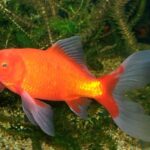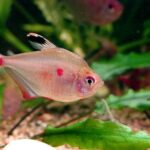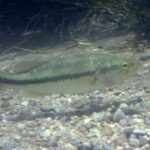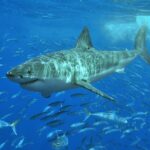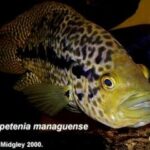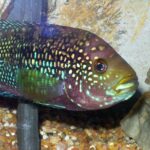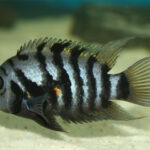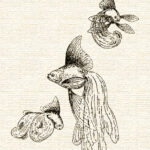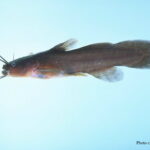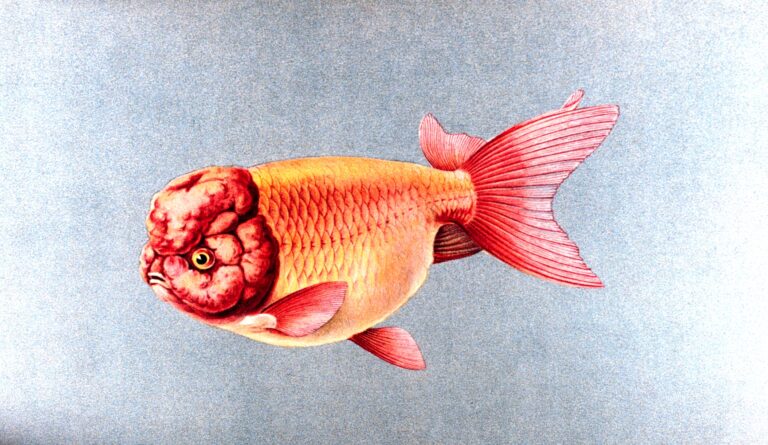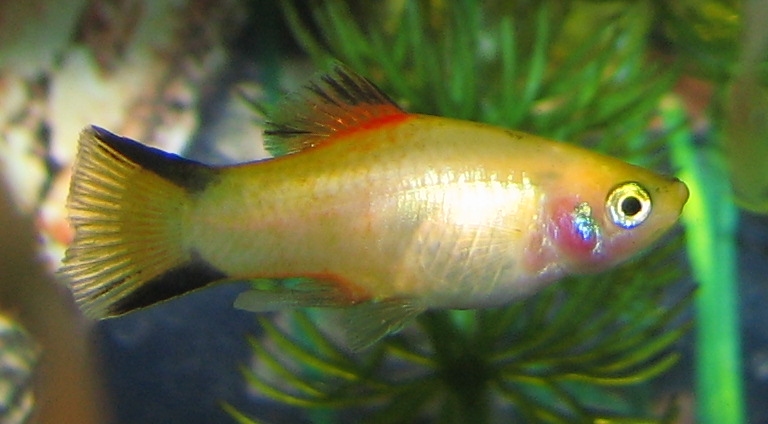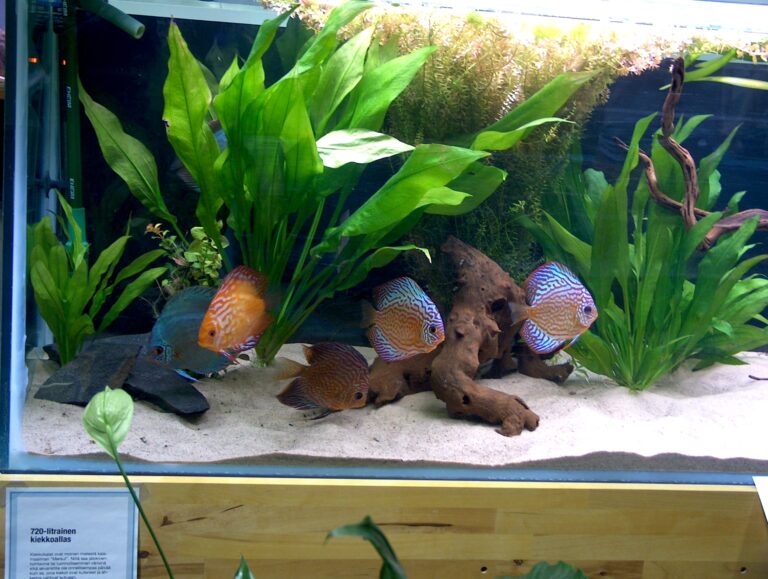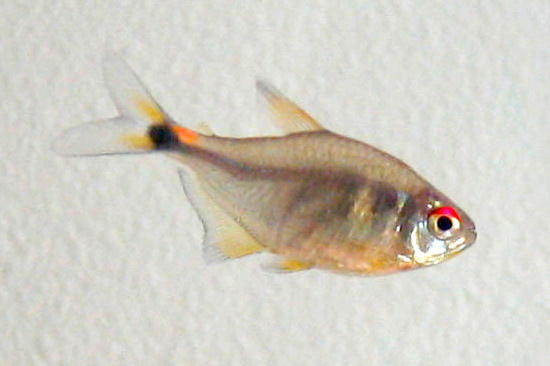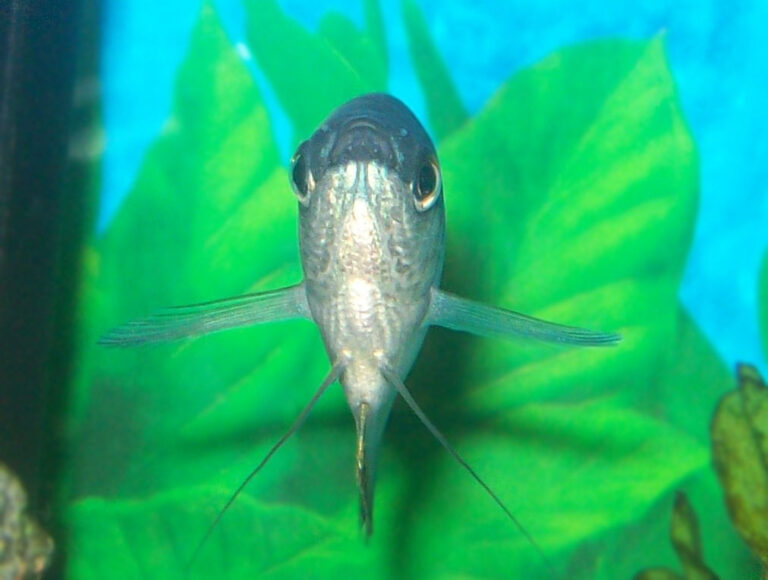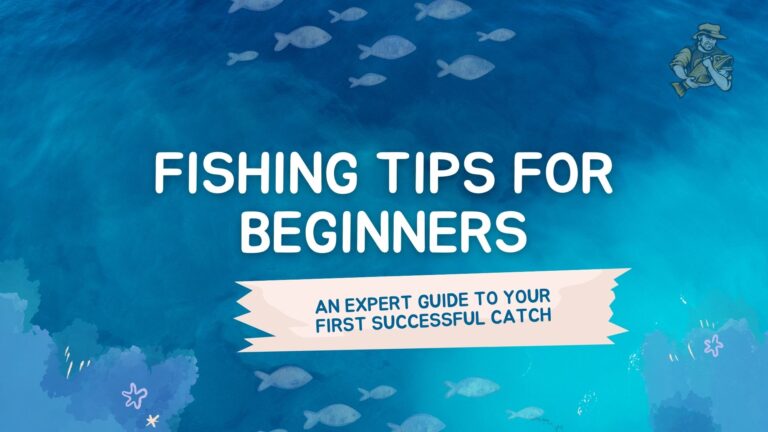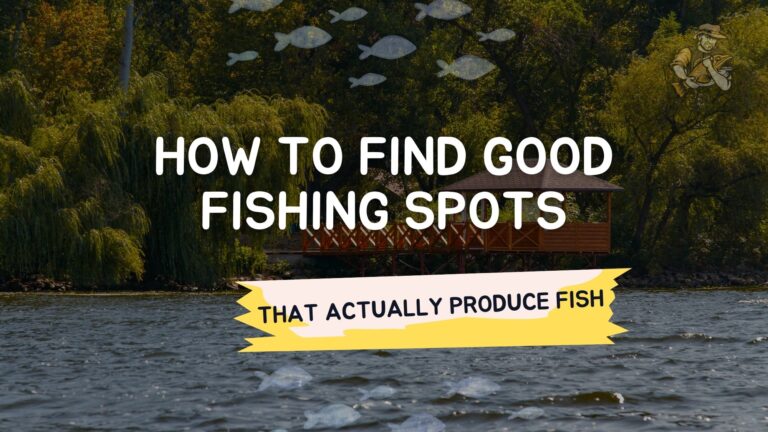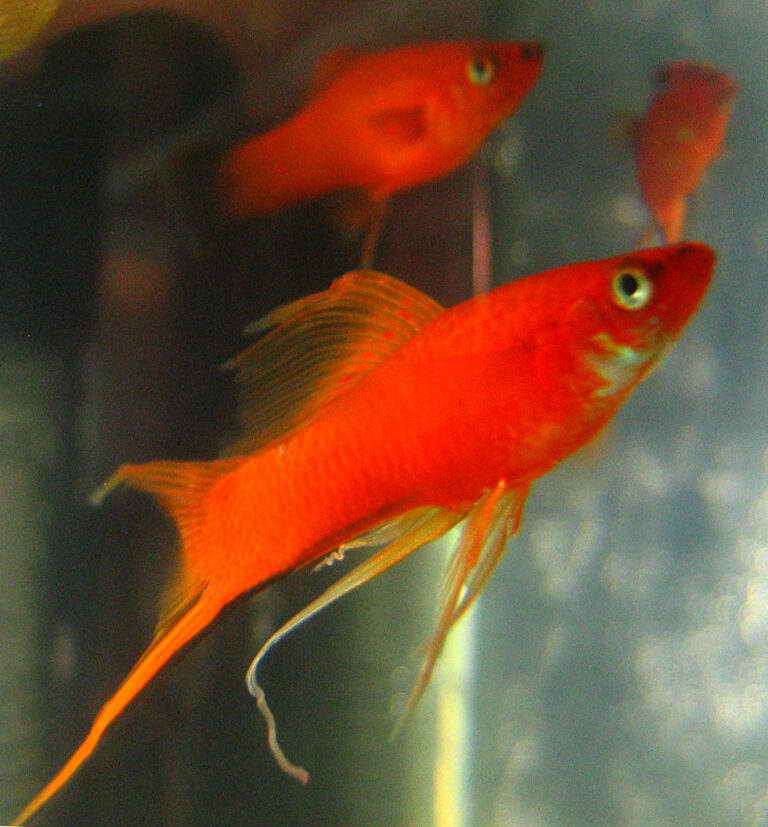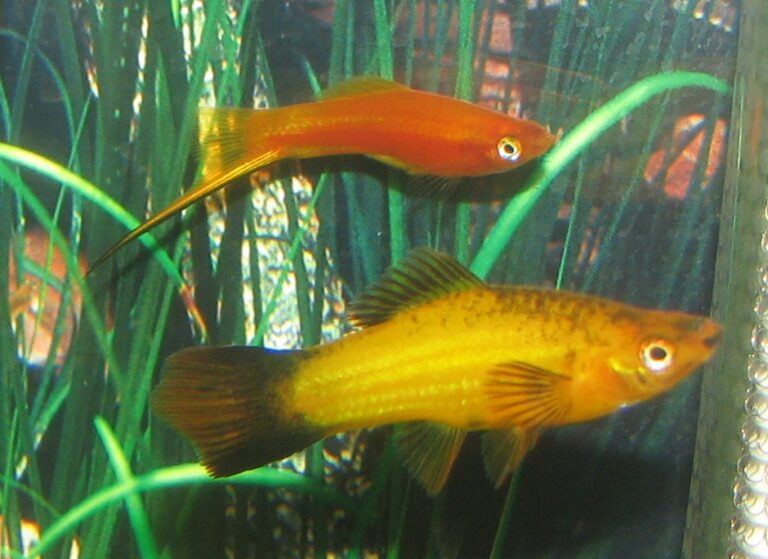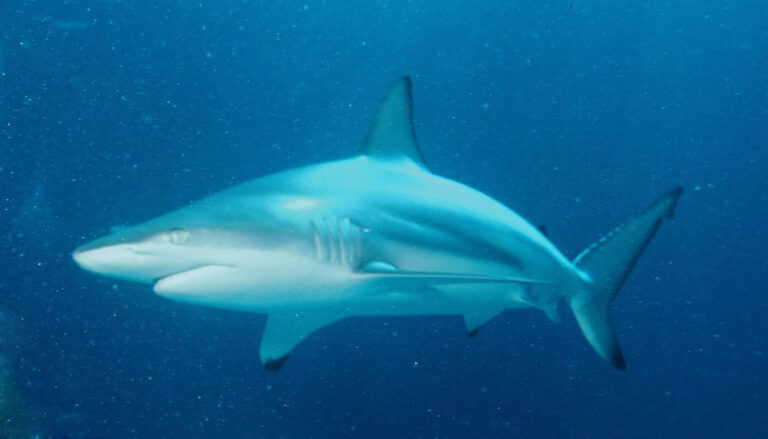Rummy Nose Tetra
By Ryan Maron | Last Modified: June 7, 2025
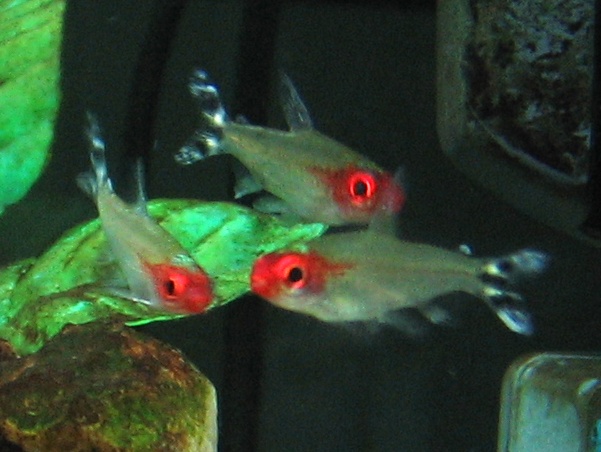
The Rummy Nose Tetra stands as one of the most distinctive and recognizable small freshwater fish species in South American river systems. Known scientifically as Hemigrammus rhodostomus, this striking characin displays a brilliant red nose and tail that contrasts beautifully with its translucent silver body. The species plays a crucial ecological role as both a consumer of small invertebrates and plankton, and as an important forage fish for larger predatory species throughout the Amazon Basin.
These schooling fish serve as vital indicators of water quality in their native habitats, often being among the first species to show stress when environmental conditions deteriorate. Their sensitivity to water chemistry changes has made them valuable biological indicators for researchers studying freshwater ecosystem health. In the aquarium trade, Rummy Nose Tetras have gained significant popularity due to their peaceful nature, stunning coloration, and fascinating schooling behaviors that create living artwork in home aquariums.
| Feature | Details |
| Common Name | Rummy Nose Tetra |
| Scientific Name | Hemigrammus rhodostomus |
| Family | Characidae |
| Typical Size | 5-6 cm (2-2.4 inches), 2-3 grams |
| Habitat | Soft-water rivers and tributaries |
| Diet | Omnivorous micropredator |
| Distribution | Amazon Basin, South America |
| Conservation Status | Least Concern |
Taxonomy & Classification
The Rummy Nose Tetra belongs to the extensive family Characidae, which encompasses over 1,100 species of freshwater fish distributed primarily throughout South America, Central America, and Africa. Within this diverse family, Hemigrammus rhodostomus represents one of the most specialized members of the genus Hemigrammus, a group containing approximately 50 described species of small, colorful tetras.
The species was first scientifically described by Ahl in 1924, though taxonomic confusion persisted for decades due to the existence of closely related species with similar appearances. Two other species commonly referred to as “rummy nose tetras” include Hemigrammus bleheri and Petitella georgiae, leading to frequent misidentification in both scientific literature and the aquarium trade. Modern molecular analysis has helped clarify these distinctions, confirming H. rhodostomus as the true Rummy Nose Tetra.
The genus name Hemigrammus derives from Greek roots meaning “half line,” referring to the incomplete lateral line characteristic of many species in this group. The species epithet rhodostomus combines Greek words meaning “red mouth,” directly referencing the distinctive crimson coloration that extends from the nose to behind the eyes. This nomenclature reflects the systematic approach to classification that emphasizes observable morphological characteristics.
Recent phylogenetic studies place the Rummy Nose Tetra within the subfamily Stethaprioninae, a group characterized by specific jaw and tooth arrangements that facilitate their feeding ecology. The evolutionary relationships within Characidae continue to be refined through ongoing molecular research, with new insights emerging about the diversification patterns that led to the remarkable species richness observed in South American freshwater systems.
Physical Description
The Rummy Nose Tetra exhibits a streamlined, laterally compressed body typical of active schooling fish, reaching maximum lengths of approximately 6 centimeters in wild populations. The most striking feature is the intense red coloration that covers the entire head region, extending from the tip of the snout to just behind the operculum. This vibrant red pigmentation results from specialized chromatophores containing astaxanthin and other carotenoid pigments, which can intensify or fade based on diet, health status, and environmental conditions.
The body displays a translucent silver base color with subtle greenish or bluish iridescence along the lateral surfaces. A faint dark horizontal stripe extends from behind the gill cover to the caudal peduncle, becoming more pronounced during periods of stress or excitement. The scales are cycloid and relatively large for the fish’s size, typically numbering 28-30 along the lateral series.
The caudal fin features distinctive black and white horizontal stripes that create a zebra-like pattern, with three prominent black bands separated by clear or white spaces. This tail coloration serves as an important identification feature and likely plays a role in school coordination and predator confusion. The remaining fins are largely transparent with subtle hints of red pigmentation, particularly noticeable in the adipose fin characteristic of characiform fishes.
Sexual dimorphism in Rummy Nose Tetras is subtle but discernible to experienced observers. Mature females typically display a more rounded body profile, particularly when carrying eggs, while males maintain a more streamlined appearance. Males may also exhibit slightly more intense coloration during breeding periods, though this difference is less pronounced than in many other tetra species. The eye is proportionally large, with a bright silver iris that enhances the fish’s alert appearance and likely aids in detecting both food items and potential threats in their natural environment.
Habitat & Distribution
The Rummy Nose Tetra inhabits the vast network of rivers and tributaries throughout the Amazon Basin, with documented populations extending from eastern Colombia and Venezuela through northern Brazil and into parts of Guyana. These fish demonstrate a strong preference for soft, acidic waters characteristic of blackwater and clearwater river systems, where pH levels typically range from 4.5 to 6.8 and total dissolved solids remain exceptionally low.
Natural populations concentrate in areas where fallen trees and dense aquatic vegetation create complex three-dimensional habitats. These environments provide both protection from predators and abundant feeding opportunities, as decomposing organic matter supports diverse communities of microorganisms and small invertebrates. Water temperatures in their native range typically fluctuate between 24-28°C throughout the year, with minimal seasonal variation due to the equatorial location.
The species shows particular affinity for river margins and tributary mouths where water movement creates gentle currents. Unlike some tetra fish varieties that prefer completely still waters, Rummy Nose Tetras actively seek areas with moderate flow that enhances oxygen levels and brings food items within reach. These microhabitats often feature sandy or muddy substrates overlaid with leaf litter, creating the tannin-stained water conditions that characterize much of the Amazon system.
Seasonal flooding cycles significantly impact habitat availability and fish distribution patterns. During high water periods, Rummy Nose Tetras disperse into temporarily flooded forest areas where they feed on terrestrial insects and plant matter. As waters recede, populations concentrate in permanent river channels and deeper pools, where increased fish density can lead to intensified predation pressure and competition for resources. This cyclical pattern influences breeding timing, growth rates, and population dynamics throughout their range.
Human activities including deforestation, dam construction, and agricultural runoff have begun to impact some populations, particularly in areas closer to major urban centers. However, the species’ extensive range and adaptability to various water conditions within their preferred parameters have helped maintain stable populations across most of their natural distribution.
Diet & Feeding Behavior
Rummy Nose Tetras function as opportunistic micropredators, employing a diverse feeding strategy that adapts to seasonal availability of food resources throughout the Amazon Basin. Their diet consists primarily of small invertebrates, including copepods, cladocerans, chironomid larvae, and various aquatic worms that inhabit the benthos and water column. This protein-rich foundation supports their active metabolism and vibrant coloration.
Plant matter comprises a significant secondary component of their natural diet, particularly during flood seasons when terrestrial vegetation becomes temporarily submerged. They consume algae, small seeds, and decomposing plant material, demonstrating the omnivorous flexibility that characterizes many successful characin species. The consumption of organic detritus also provides essential nutrients and likely contributes beneficial bacteria to their digestive systems.
Feeding behavior in wild populations exhibits distinct patterns related to time of day and environmental conditions. Peak feeding activity occurs during dawn and dusk periods when many prey species become more active and vulnerable. The fish employ both surface feeding and mid-water hunting strategies, often positioning themselves near structures where current patterns concentrate food items. Their large eyes and quick reflexes make them efficient at capturing small, mobile prey even in low-light conditions.
School feeding coordination represents one of the most fascinating aspects of Rummy Nose Tetra behavior. When a food source is located by individual fish, subtle body movements and positioning changes rapidly communicate the discovery to nearby school members. This collective feeding response increases foraging efficiency and reduces individual exposure to predation risk. The intensity of their red coloration often increases during active feeding periods, possibly serving as a visual signal to coordinate group activities.
Seasonal dietary shifts reflect the dynamic nature of Amazonian ecosystems. During dry seasons when water levels drop, terrestrial arthropods become less available, and the fish focus more heavily on aquatic invertebrates and algae. Conversely, flood seasons bring abundant terrestrial food sources, allowing for rapid growth and conditioning for subsequent spawning activities.
Behavior & Adaptations
The Rummy Nose Tetra has evolved sophisticated schooling behaviors that represent some of the most cohesive group dynamics observed in freshwater fish species. Schools typically consist of 20-100 individuals that move with remarkable synchronization, creating the impression of a single, larger organism. This collective behavior provides significant advantages including improved predator detection, enhanced foraging efficiency, and reduced individual energy expenditure through hydrodynamic benefits.
Communication within schools occurs through multiple sensory channels, including visual cues from the distinctive head and tail coloration patterns, lateral line detection of pressure waves, and chemical signals. The bright red nose serves as a visual beacon that helps maintain school cohesion, particularly in the tannin-stained waters of their natural habitat where visibility is often limited. The striped tail pattern creates visual confusion for predators attempting to target individual fish within the moving school.
Stress response mechanisms in Rummy Nose Tetras are highly developed and immediately observable. When environmental conditions deteriorate or threats are detected, the characteristic red coloration can fade dramatically within minutes, serving as both a stress indicator and a potential camouflage mechanism. This rapid color change results from the contraction of chromatophores containing red pigments, effectively reducing the fish’s visibility to predators.
Territorial behavior is minimal in this species, as their schooling lifestyle requires cooperation rather than competition for space. However, subtle hierarchies do exist within schools, with larger, more mature individuals often taking positions at the school’s periphery where they can better detect threats and food sources. These “sentinel” fish play crucial roles in group decision-making regarding movement patterns and feeding locations.
Adaptation to water chemistry fluctuations represents a key survival mechanism in their variable Amazonian environment. Rummy Nose Tetras possess efficient osmoregulatory systems that allow them to function in extremely soft water conditions where many other fish species struggle. Specialized gill structures and kidney adaptations help maintain proper ion balance even when dissolved mineral content approaches zero, a common condition in blackwater systems during peak flood periods.
Reproduction & Life Cycle
Rummy Nose Tetra reproduction follows seasonal patterns closely tied to Amazonian flood cycles, with peak spawning activity occurring during the transition from dry to wet seasons when food availability increases and water parameters stabilize. Sexual maturity is typically reached at 8-12 months of age when fish attain lengths of approximately 4-5 centimeters, though environmental conditions can influence the timing of reproductive readiness.
Courtship behavior involves subtle changes in schooling patterns, with mature individuals forming smaller sub-groups within the larger school. Males display intensified coloration and engage in gentle pursuit behaviors, swimming alongside females while exhibiting slightly exaggerated swimming motions. Unlike many characin species, Rummy Nose Tetras do not establish defined territories for breeding, instead utilizing broadcast spawning strategies in areas with dense vegetation or fine-leaved plants.
The spawning process typically occurs during early morning hours when water temperatures are rising and dissolved oxygen levels peak. Females release between 50-150 adhesive eggs that attach to plant surfaces or settle among fine substrate materials. The eggs are small, measuring approximately 1.2-1.5 millimeters in diameter, and exhibit a slightly amber coloration that provides camouflage against natural substrates.
Embryonic development progresses rapidly in the warm tropical conditions, with hatching occurring within 24-36 hours post-fertilization. Newly hatched larvae remain attached to spawning substrates through a yolk sac that provides nutrition for the first 3-4 days of life. During this critical period, the developing fish are highly vulnerable to predation and environmental fluctuations, with survival rates typically ranging from 15-30% under natural conditions.
Juvenile development follows a predictable pattern, with the characteristic red nose coloration beginning to appear at approximately 4-6 weeks of age. Young fish initially form small schools separate from adults, gradually integrating with larger groups as they mature. Growth rates vary significantly based on food availability and water quality, with optimal conditions supporting rapid development that can produce reproductively mature fish within their first year of life.
Parental care is absent in this species, which relies instead on high reproductive output and strategic spawning timing to ensure population continuity. The lack of parental investment allows adults to focus energy on survival and subsequent reproductive efforts, supporting the multiple spawning events that may occur throughout favorable seasons.
Predators & Threats
Rummy Nose Tetras face predation pressure from a diverse array of species throughout their life cycle, with threats varying significantly between juvenile and adult stages. Larger characins, including piranhas and various predatory tetras, represent primary threats to adult populations. Cichlids such as angelfish, discus, and various pike cichlids actively hunt schooling tetras, using ambush strategies to capture individuals separated from the main group.
Avian predators, particularly kingfishers and herons, pose significant threats in shallow water areas where schools venture close to the surface during feeding activities. These birds have evolved specialized hunting techniques for capturing small, fast-moving fish, often targeting the most visible individuals with bright coloration. The Rummy Nose Tetra’s distinctive red markings, while beneficial for school coordination, can make individuals more conspicuous to visual predators.
Juvenile fish face additional threats from invertebrate predators including dragonfly nymphs, diving beetles, and various aquatic arthropods that inhabit the same microhabitats preferred by young tetras. During the vulnerable larval and early juvenile stages, even small predators can significantly impact local populations, making spawning site selection critical for reproductive success.
Parasitic threats include various protozoan and metazoan species common in tropical freshwater systems. Ichthyophthirius, gill flukes, and intestinal worms can weaken individual fish and make them more susceptible to predation. The schooling behavior that provides protection from predators can unfortunately facilitate rapid parasite transmission throughout the group when conditions favor pathogen development.
Environmental threats have increased in recent decades due to human activities throughout the Amazon Basin. Deforestation leading to increased sedimentation, agricultural chemical runoff, and altered hydrology from dam construction all impact water quality and habitat availability. Mercury contamination from mining activities poses particular concerns, as even sub-lethal concentrations can affect reproduction and immune system function.
Climate change presents emerging threats through altered precipitation patterns that could disrupt the flood cycles crucial for reproduction and feeding. Changes in water temperature and chemistry associated with global warming may push some populations beyond their physiological tolerance limits, particularly in areas already stressed by human activities.
Conservation Status
The International Union for Conservation of Nature currently classifies the Rummy Nose Tetra as Least Concern due to its extensive range throughout the Amazon Basin and apparently stable population numbers across most of its distribution. However, this classification masks significant regional variations in population health and habitat quality that warrant continued monitoring and conservation attention.
Population assessments conducted by various South American research institutions indicate that while overall numbers remain substantial, local declines have been documented in areas subject to intensive human development. River systems near major urban centers including Manaus, Iquitos, and Leticia show reduced tetra diversity and abundance compared to historical records, suggesting cumulative impacts from multiple stressors.
The species benefits from its inclusion in several large protected areas throughout the Amazon Basin, including national parks and indigenous territories where traditional management practices help maintain ecosystem integrity. These protected areas serve as crucial refugia that can support population recovery in adjacent areas and provide source populations for natural recolonization efforts.
International trade regulations under CITES do not currently apply to Rummy Nose Tetras, as wild collection pressure appears manageable given their high reproductive output and widespread distribution. However, most specimens in the aquarium trade now originate from commercial breeding operations in Southeast Asia and Florida, reducing pressure on wild populations while meeting market demand.
Research priorities identified by conservation organizations include improved population monitoring in remote areas, assessment of climate change impacts on critical spawning habitats, and evaluation of cumulative effects from multiple human stressors. Collaborative efforts between governments, NGOs, and local communities have begun addressing some threats through improved land use planning and water quality protection measures.
The species serves as an indicator for broader Amazon conservation efforts, as maintaining healthy Rummy Nose Tetra populations requires preservation of the complex, intact ecosystems they depend upon. Their sensitivity to water quality changes makes them valuable monitoring tools for assessing the effectiveness of conservation strategies throughout their range.
Human Interaction
The relationship between humans and Rummy Nose Tetras has evolved significantly since the species first entered the international aquarium trade in the 1960s. Indigenous communities throughout the Amazon Basin have long recognized these fish as indicators of water quality and ecosystem health, incorporating observations of tetra behavior and abundance into traditional environmental knowledge systems used for resource management decisions.
Commercial aquarium collection initially focused on wild-caught specimens exported primarily from Colombia and Brazil. However, the development of successful captive breeding programs has largely eliminated dependence on wild collection, with most trade specimens now originating from commercial facilities in Asia, particularly Singapore and Malaysia. This shift has reduced pressure on natural populations while making the species more readily available to aquarium enthusiasts worldwide.
In the aquarium hobby, Rummy Nose Tetras have gained recognition as one of the most desirable schooling species due to their peaceful temperament, striking appearance, and fascinating group behaviors. Their reputation as sensitive indicators of water quality has made them popular among experienced aquarists who appreciate their role as “canaries in the coal mine” for detecting aquarium management problems before other species show stress symptoms.
Scientific research applications have expanded beyond basic taxonomic and ecological studies to include investigations of schooling behavior, color change mechanisms, and stress physiology. Universities and research institutions frequently use Rummy Nose Tetras as model organisms for studying group dynamics and collective behavior in vertebrates, contributing to broader understanding of social organization in animal populations.
Ecotourism operations throughout the Amazon Basin increasingly feature Rummy Nose Tetras as flagship species for snorkeling and underwater photography activities. Their predictable schooling behavior and tolerance of careful human observation make them excellent subjects for eco-tourists seeking to experience Amazonian aquatic biodiversity. This economic value provides additional incentives for habitat conservation in regions dependent on tourism revenue.
Educational programs in aquariums and schools worldwide utilize Rummy Nose Tetras to teach concepts related to ecology, behavior, and conservation. Their dramatic color changes in response to stress provide compelling demonstrations of animal physiology and environmental adaptation, making complex scientific concepts accessible to students of all ages.
Interesting Facts
The synchronized swimming abilities of Rummy Nose Tetra schools have inspired biomimetic research for underwater robotics applications. Engineers study their coordinated movements to develop algorithms for autonomous underwater vehicle swarms, particularly focusing on how individual fish process information and make rapid collective decisions without centralized control mechanisms.
Color-changing capabilities in Rummy Nose Tetras occur at remarkable speeds, with full transitions from bright red to pale pink achievable within 2-3 minutes. This physiological response involves specialized neural pathways that control chromatophore behavior, representing one of the fastest color change systems documented in freshwater fish species. The mechanism has attracted interest from researchers studying adaptive camouflage in aquatic environments.
Despite their small size, Rummy Nose Tetras possess exceptional swimming endurance that allows them to maintain continuous movement for extended periods without apparent fatigue. Studies using respirometry techniques have revealed metabolic adaptations that support this active lifestyle, including enhanced oxygen uptake efficiency and specialized muscle fiber arrangements optimized for sustained swimming performance.
The species exhibits remarkable homing abilities, with tagged individuals returning to specific locations within their home range after displacement distances exceeding several kilometers. This navigation capability likely involves multiple sensory modalities including chemical recognition of water characteristics, magnetic field detection, and visual landmark identification, though the precise mechanisms remain incompletely understood.
Rummy Nose Tetras demonstrate unexpected cognitive abilities including individual recognition within schools and simple learning behaviors related to feeding and predator avoidance. Research has documented memory retention periods extending beyond several weeks, challenging traditional assumptions about cognitive capacity in small schooling fish species.
Temperature preferences in this species show remarkable precision, with optimal performance occurring within a narrow range of 25-27°C. Deviations of just 2-3 degrees can trigger measurable changes in activity levels, feeding behavior, and school cohesion, highlighting their sensitivity to environmental conditions and potential vulnerability to climate change impacts.
The distinctive striped tail pattern serves multiple functions beyond predator confusion, including species recognition signals that help prevent hybridization with closely related tetras sharing similar habitats. Different tetra species varieties have evolved various tail patterns that facilitate species identification during the critical mate selection process.
Frequently Asked Questions
How can you distinguish between the three different rummy nose tetra species?
The true Rummy Nose Tetra (Hemigrammus rhodostomus) has red coloration that extends only to behind the eyes, while the Firehead Tetra (H. bleheri) shows red extending further back onto the body. The False Rummy Nose (Petitella georgiae) displays a more orange-red coloration and different tail stripe patterns. Body shape and fin ray counts also provide reliable identification features for experienced observers.
Why do Rummy Nose Tetras lose their red coloration in aquariums?
Color fading typically indicates stress from poor water quality, inappropriate temperature, inadequate diet, or social isolation. These fish require very soft, slightly acidic water conditions and must be kept in groups of at least 6-8 individuals to maintain natural behaviors. Proper nutrition including carotenoid-rich foods helps maintain vibrant coloration, while stable environmental conditions prevent stress-induced fading.
What water parameters do Rummy Nose Tetras need to thrive?
Optimal conditions include pH between 5.0-6.8, very soft water with hardness below 5 dGH, temperatures of 24-28°C, and excellent filtration maintaining low nitrate levels. These fish are extremely sensitive to water chemistry changes and require gradual acclimation to new conditions. Regular water changes with properly conditioned water are essential for long-term health and color retention.
Can Rummy Nose Tetras be bred in home aquariums?
While challenging, captive breeding is possible with proper setup including very soft, acidic water, fine-leaved plants for spawning substrate, and conditioning with high-quality live or frozen foods. Breeding tanks should be dimly lit with gentle filtration, and parents must be removed after spawning to prevent egg predation. Success rates are generally low compared to other tetra species, requiring patience and attention to detail.
Conclusion
The Rummy Nose Tetra represents a remarkable example of evolutionary adaptation to the unique conditions of Amazonian freshwater ecosystems. Their role as both indicator species and integral components of aquatic food webs underscores the importance of maintaining healthy river systems throughout their range. As human pressures continue to impact these environments, the continued success of species like the Rummy Nose Tetra will depend on coordinated conservation efforts that preserve the complex ecological relationships supporting South America’s extraordinary freshwater biodiversity.
Share The Article:
More Fish Species:
-
Ranchu Goldfish
The Ranchu Goldfish represents one of the most distinctive and culturally significant ornamental fish varieties in the aquatic world….
-
Platy Fish
The Platy Fish, scientifically known as Xiphophorus maculatus, represents one of the most popular and widely distributed freshwater aquarium…
-
Discus Fish
The Discus Fish (Symphysodon spp.) stands as one of the most revered species in the freshwater aquarium trade, earning…
-
Head and Tail Light Tetra
The Head and Tail Light Tetra (*Hemigrammus ocellifer*) stands as one of South America’s most distinctive characin species, instantly…
-
Blue Gourami
The Blue Gourami (*Trichogaster trichopterus*) stands as one of the most recognizable and adaptable freshwater fish species in tropical…
-
Basking Shark
The Basking Shark stands as one of the ocean’s most magnificent gentle giants, representing the second-largest fish species on…
Discover
-
River Fishing Techniques: Master the Moving Water
Fishing rivers presents a unique set of challenges and rewards that I’ve come to appreciate over my three decades…
-
Texas Fishing License Guide: 2025 Costs & Requirements
I still remember the day a Texas game warden approached me on Lake Texoma while I was reeling in…
-
Fishing Tips for Beginners: An Expert Guide to Your First Successful Catch
Getting started with fishing can feel overwhelming. Trust me, I’ve been there – staring at walls of equipment, trying…
-
Louisiana Redfish Fishing: Best Spots & Tactics for Beginners
Finding that first bull red is a moment you never forget. The pull, the power – it’s something special….
-
How to Find Good Fishing Spots That Actually Produce Fish
Finding productive fishing spots is often what separates successful anglers from those who go home empty-handed. It’s not just…
-
How to Spool a Baitcaster for Beginners: 6 Simple Steps
I remember the first time I tried spooling a baitcaster reel. What should have been a simple 15-minute job…
Discover
-
Red Swordtail
The Red Swordtail stands as one of the most recognizable and cherished freshwater aquarium fish in the world. Known…
-
Sailfin Molly
The Sailfin Molly stands as one of the most distinctive freshwater fish species in both wild ecosystems and aquarium…
-
Swordtail Fish
The Swordtail Fish (Xiphophorus hellerii) stands as one of the most recognizable and beloved species in the aquarium trade,…
-
Tiger Barb
The Tiger Barb (Puntigrus tetrazona) stands as one of Southeast Asia’s most recognizable freshwater cyprinids, distinguished by its vibrant…
-
Blacktip Shark
The Blacktip Shark (Carcharhinus limbatus) stands as one of the most recognizable and ecologically significant predators in tropical and…
-
Pennsylvania Fishing License: Complete Guide for Anglers in 2025
Getting your Pennsylvania fishing license sorted isn’t exactly the most exciting part of fishing, but it’s absolutely necessary if…

